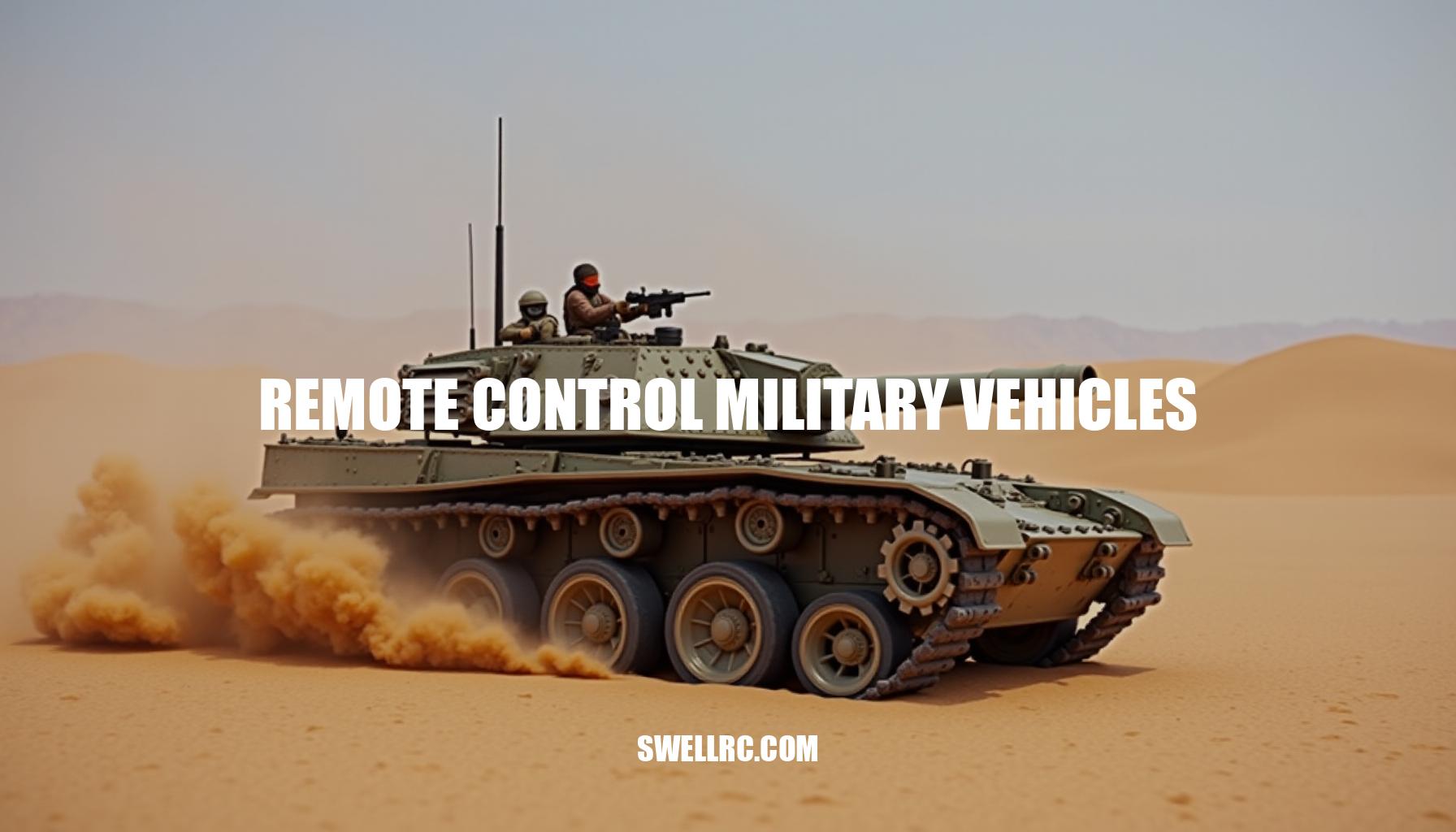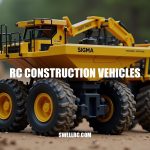The Thrill of Remote Control Military Vehicles: A Hobbyist’s Guide
I still remember the first time a scale RC tank crawled over my driveway curb, turret yawing with that believable mechanical whine. It didn’t feel like a toy; it felt like a tiny feat of engineering, a distilled version of the big machines I grew up reading about. Remote control military vehicles sit at the crossroads of design precision, control finesse, and authentic sound-and-motion simulation.
They evolved alongside the broader RC hobby—progress that traces all the way back to early breakthroughs like the first remote control car, whose simple radio link and drivetrain laid the groundwork for today’s highly detailed, battlefield-ready models. From the powerful RC battle tank to versatile RC army trucks, these radio-controlled vehicles embody a unique blend of realism and fun. Whether you’re captivated by model armored vehicles or intrigued by the mechanics of RC military tanks, the journey from early prototypes to modern replicas reveals the innovation and passion fueling this hobby.
In this guide, I’ll share what makes these models tick, how to pick your first one, and where the community is pushing innovation next.
2. The Evolution and Engineering Behind Military RC Models
Military RC vehicles have evolved significantly from their early days rooted in scale modeling, training aids, and hobby-grade experimentation. As electronics became smaller and more reliable, these vehicles—ranging from RC military models for adults to intricate remote control armored cars—advanced with proportional throttle and turret control, sophisticated multi-channel radio systems, and suspension that truly enhanced performance.
- Power Systems: The diversification of power systems offers options tailored to enthusiasts’ preferences. Electric models provide clean, instant torque, nitro brings a rev-happy character, and gasoline-powered rigs, like those inspired by durable gas-powered RC truck kits, deliver long runtimes with realistic engine notes.
- Control Systems: The maturation from basic two-channel sets to advanced multi-protocol radios revolutionized operation. Today’s radio-controlled vehicles can be managed via a universal RC car remote control, which is especially beneficial for hobbyists managing mixed fleets — enabling seamless binding to tanks, trucks, and even aircraft receivers without gear swapping.
- Scaling Challenges: Scaling remains a key consideration in building and using military RC vehicles. Popular scales like 1/16 for tanks balance detail, indoor/outdoor versatility, and accessories, while 1/10 scale trucks excel for trail realism and parts availability. This ensures that models such as the RC soldier jeep and armored cars perform authentically in their environments.
The most successful builds integrate rugged drivetrains, metal gearboxes, sealed bearings, and intelligent weight distribution. These technical aspects prevent issues such as tanks nosediving over obstacles and help armored cars maintain straight tracking under throttle, delivering an optimized and immersive remote control experience.
2a. Engine Types for Military RC Vehicles — Pros and Cons (Comparison Table)
When choosing between electric RC, nitro RC, and gas RC models, it’s important to consider factors like drivetrain torque, runtime, maintenance, and realism to find the best match for your preferences and skill level. Below is a helpful table overview to guide your shopping decision:
| Type | Pros | Cons | Realism | Ideal For |
|---|---|---|---|---|
| Electric | Instant torque, quiet operation, low maintenance, excellent low-speed control for tanks | Limited runtime per battery pack, requires battery care | High realism in motion, moderate in sound; can add sound units or smoke for immersion | Beginners to advanced builders who value precision |
| Nitro (Glow) | Lively throttle feel, authentic engine behavior, quick refueling | Tuning sensitive, louder operation, more maintenance required | Good engine character, but noise might break scale illusion if vehicle is small | Tinkerers who enjoy carburetor tuning and mechanical feel |
| Gasoline (Petrol) | Long runtimes, strong torque, economical fuel, deep engine sound | Heavier setups, requires vibration management, better suited for larger scales | Excellent realism for big armored cars and trucks | Large-scale enthusiasts seeking endurance and presence |
Each drivetrain offers unique benefits and challenges. Electric RC models shine with their instant drivetrain torque and low-maintenance nature, making them perfect for beginners and those wanting smooth control. In contrast, nitro RC vehicles provide a thrilling mechanical experience with lively throttle responses but demand more upkeep and tuning skills.
Gas RC vehicles excel in runtime and realism, particularly for larger scale models, though they require managing added weight and vibrations. Considering these aspects will help you pick the right RC type that balances performance, maintenance, and realistic operation for your hobby needs.
3. Types of Remote Control Military Vehicles Available Today
Ground vehicles are the heart of the category, encompassing tracked MBTs and assault guns, wheeled APCs, soldier jeeps, and expedition trucks. For enthusiasts seeking a realistic overlander aesthetic, even civilian-derived platforms like the RC Nissan Patrol can provide valuable insights into suspension travel and scale detailing in RC army truck models, perfect for enhancing model armored vehicles. In the air, the options range from military RC drones such as quad drones for recon-style FPV to scale jets and heavy-lift helicopters, allowing for dynamic RC battlefield simulation.
Two classics that pair beautifully with ground operations include the RC F-35 jet for fast aerial flybys and the Boeing CH-47 Chinook RC helicopter, renowned for realistic transport-style presence and authentic rotor sound.
- Ground Models: RC army trucks, tracked MBTs, assault guns, scooters, and soldier jeeps delivering authentic scale and performance.
- Air Models: Military RC drones for reconnaissance, fast scale jets like the RC F-35, and heavy-lift helicopters such as the Chinook for transport realism.
- Watercraft: From patrol boats to landing craft and battleships, naval RC models bring full-theater scenarios to life with intricate detailing and remote control weapon systems.
- Input Technology: Innovative hand-control remote car interfaces leverage gesture-driven control, lowering the learning curve while enhancing the futuristic appeal of armored vehicle operation.
Adding to the immersion, remote control weapons systems integrated into RC battlefield simulation setups greatly enrich tactical gameplay and realism. By combining expertly crafted model armored vehicles with sophisticated aerial and naval counterparts, hobbyists can orchestrate expansive battle scenarios that showcase their skill and attention to detail. For those interested in exploring these cutting-edge technologies and a wide selection of models, visit SwellRC, a trusted source for the latest in military RC drones, RC army trucks, naval RC vessels, and more.
4. Advanced Performance and Simulation Realism
Modern RC battle tanks are true mini-simulators, offering a remarkable level of detail and realism. Advanced recoil simulation units synchronize cannon recoil with muzzle flash LEDs and momentary drivetrain pauses, creating a lifelike firing experience. Integrated smoke generators add to the immersion by producing realistic exhaust plumes that breathe life into every move.
On the mechanical side, sophisticated suspension systems featuring adjustable torsion bars and oil-filled shocks combine with metal tracks and rubber pads to deliver exceptional terrain adaptability. These features provide traction and handling akin to dedicated off-road vehicles. Additionally, proportional ESCs enable proportional throttle input, allowing for precise control and delicate maneuvers—critical for tactical positioning such as hull-down concealment.
Gyroscopic stabilization technology further enhances turret steadiness over uneven terrain, making each operation a rewarding blend of technical authenticity and engaging fun.
5. The Community, Customization, and DIY Modifications
The RC military scene thrives on forums, club battles, and weekend paint sessions, bringing enthusiasts together in vibrant community events. You’ll find scale masters who specialize in scale weathering, meticulously applying pigments and oil washes to create authentic tank finishes. Alongside, electronics tinkerers engage in DIY RC modifications, like integrating flight controllers into armored cars to achieve superior gyro stabilization and smoother handling.
Easy upgrades often include:
- Metal gearboxes for enhanced durability
- Brass bushings-to-bearing swaps to reduce friction
- Improved track tensioners for better performance
- ESC tuning to optimize startup smoothness and responsiveness
My own breakthrough came when I reprogrammed throttle curves and added a modest gyro—turns became tighter, turret shots steadier, and the model felt twice as responsive. To set a control precision baseline, I often compare how crisply a well-sorted rally car like a remote control Subaru rotates versus how a heavy armored vehicle pivots; it’s an excellent way to gauge whether your tank’s ESC and gear ratio are perfectly dialed: https://www.swellrc.com/remote-control-subaru/.
The community’s collaborative spirit—sharing STL files, paint recipes, and wiring diagrams—transforms every garage into a lab of innovation and learning, pushing the boundaries of customization and enhancing the overall RC experience.
6. Choosing Your First Remote Control Military Vehicle (Buyer’s Guide)
When selecting your first beginner RC tank, consider scale selection carefully to balance detail and practicality. For instance, 1/16 scale tanks offer a good mix of detail and manageable size, making them ideal for newcomers who want a realistic experience without overwhelming complexity. Meanwhile, 1/10 scale armored trucks excel in parts availability and provide lively trail adventures, perfect for those who prioritize ease of maintenance and outdoor fun.
Smaller micro scales are best suited for indoor courses where space is limited.
Checking radio compatibility is crucial. Multi-protocol radios and universal-style transmitters simplify controlling mixed fleets, allowing you to operate various models seamlessly. These radios not only accommodate different brands but also let you upgrade your collection without needing multiple controllers.
Battery life is another important factor, especially for tanks equipped with sound and smoke units that consume additional power. It’s wise to have at least two battery packs or invest in a fast charger to maximize runtime during your sessions.
When debating RTR vs kit, beginners often benefit most from Ready-To-Run (RTR) models like a 1/16 scale tank featuring a metal gearbox and proportional turret controls. Similarly, a simple 1/10 soldier jeep with waterproof electronics makes a great introduction to RC vehicles, while camera-equipped drones offer engaging recon-style flight experiences.
Always prioritize spares availability, focusing on models with accessible replacement parts and metal running gear where it counts for durability. Lastly, choose a radio system you can grow into; universal-compatibility transmitters provide excellent long-term value as you expand your motor pool.
| Factor | Recommendation |
|---|---|
| Scale Selection | 1/16 tanks for detail, 1/10 trucks for parts, micro scales for indoor |
| Radio Compatibility | Multi-protocol or universal transmitters |
| Battery Life | At least two packs or fast charger, especially with sound/smoke units |
| RTR vs Kit | RTR preferred for beginners with metal gearbox and proportional controls |
| Spares Availability | Prioritize models with metal running gear and accessible parts |
6a. Ideal First Models — Quick Comparison (Chart)
When exploring RC war vehicle kits, it’s important to understand the unique features each model offers, especially if you’re comparing options as a beginner. The following comparison chart highlights key pros and cons of popular beginner RC choices, helping you decide which vehicle best suits your interest and skill level.
| Model | Pros | Cons | Best For |
|---|---|---|---|
| 1/16 RTR Tank | High realism, proportional turret, big community | Heavier upkeep, more features to learn | Hobbyists who want immersion |
| 1/10 Soldier Jeep/Scout Car | Easy to drive, trail-friendly, parts easy to find | Less turret/action complexity | Outdoor exploring and light scale ops |
| Recon Drone (entry FPV) | Situational awareness, quick setup | Learning curve for camera/radio setup | Pairing with ground vehicles in scenarios |
From the detailed mechanics of an RTR tank suited for immersive scale battles, to the simplicity and versatility of the soldier jeep for rugged outdoor adventures, and the advanced situational capabilities of an FPV recon drone, these beginner RC choices cover various interests. This snapshot approach to RC war vehicle kits provides a clear starting point whether you lean towards ground-based combat realism or aerial reconnaissance support in your RC scenarios.
7. Conclusion — The Modern Frontier of RC Military Innovation
What keeps me hooked is how these models compress realistic engineering into something you can tune on a workbench—suspension geometry you can feel, control curves you can shape, and audiovisual systems that trick your senses in the best way. We’ve come a long way from simple radios to multi-protocol radios that offer unparalleled compatibility, smart stabilization, and highly durable drivetrains. The future of RC military vehicles looks even better with innovations like hybrid powertrains that expertly blend torque, runtime, and sound, and advanced AR integration overlays designed for immersive battlefield games.
Like any good build, progress is iterative: a tweak here, a better bearing there, and suddenly your ‘good’ becomes ‘great.’ Whether you’re into trail-capable trucks or armored rigs holding a position under fire, there’s always room to grow—and another satisfying “aha” moment waiting on your next test run.
This continuous hobby innovation pushes the envelope, combining engineering precision with the latest technology to redefine what’s possible in RC military vehicles.
Frequently Asked Questions
- What are remote control military vehicles used for?
Primarily for hobby enjoyment, scale modeling, and friendly competitions, but also for education and STEM projects that demonstrate mechanics, control systems, and tactics. Clubs run mock battles and convoy events that simulate reconnaissance, logistics, and combined-arms coordination. - Are there realistic RC tanks that can fire projectiles?
Yes. Many 1/16 and larger tanks include IR battle systems or low-power BB mechanisms with recoil, muzzle flash LEDs, and synchronized sound. These are designed for safe, hobby-grade play and club battle rules—not high-impact use. - How does the control system on RC armored vehicles work?
A multi-channel radio sends signals to a receiver that routes commands to ESCs, servos, and modules. One stick often drives the tracks (mixed for differential steering) while other channels manage turret rotation, elevation, firing effects, lights, and sound. - What is the difference between electric and gas-powered RC military vehicles?
Electric offers quiet operation, precise low-speed control, and minimal maintenance—great for tanks. Gas (and nitro) deliver long runtimes and engine character but add weight, vibration, and more maintenance, favoring larger wheeled armor and trucks. - Which RC aircraft models pair well with military ground vehicles?
Stable camera drones for recon and scale aircraft like transport helicopters or modern jets create compelling combined scenarios. Choose manageable wingspans and flight times that match your ground session length and field size. - How can you build your own custom RC military vehicle?
Start with a proven kit or RTR base, then upgrade running gear (metal gearbox, bearings), add a sound/smoke unit, and customize the body with paint, weathering, and 3D-printed details. Tune ESC curves and consider a gyro for smoother turret or steering control.



